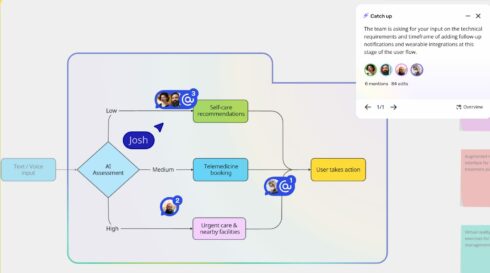
The collaboration workspace platform Miro has announced a new evolution of its platform called the Innovation Workspace, which the company says is the most significant update to the platform since 2012.
According to the company, other productivity apps follow a document-first or task-first approach, while Miro follows a canvas-first approach. This makes it easier to move back and forth between unstructured work like ideation to structured work like diagramming, documentation, task tracking, and prototyping.
“Over the past 13 years, we’ve innovated and led the market, from introducing a digital whiteboard solution, to establishing the visual collaboration category, and now – the Innovation Workspace. Through it all, we’ve stayed true to our core belief that the canvas is king. That’s because the canvas gives teams an infinite, flexible space to innovate without constraints,” said Jeff Chow, CPTO of Miro. “A canvas-first approach connects teams and their work in all formats, including messaging, task tracking, documentation, virtual meetings, and data retrieval. It’s a space to easily move from a set of ideas to a tangible output. Miro is where work gets done, instead of just focusing on the progress of work.”
RELATED: Miro launches AI-based idea generation platform Intelligent Canvas
Innovation Workspace acts as a central hub for all of a project’s assets and tasks, even third-party documents from tools like Microsoft 365 and Google Workspace. It integrates with over 150 other workplace applications to adapt to teams’ existing workflows.
By bringing everything into one canvas, a research team can take in sticky notes, text, documents, diagrams, and other unstructured data and turn it into a structured product brief much faster than previously possible. The product manager can then take that brief and quickly turn it into a prototype.
Alternatively, Miro’s AI itself can be used to create prototypes, documents, briefs, or diagrams based on that unstructured data. In its announcement video, Miro worked through an example of taking a bunch of sticky notes with ideas for a travel app, highlighting them, and having the AI create a product brief, diagrams, a plan for how each member on the team will work on it, and even a prototype of the app.
Innovation Workspace also includes the Canvas SDK, customizable widgets, and AI Action shortcuts. For example, with the assistance of AI, a product manager could create a shortcut that turns user research questions into a full script for an interview.
To further enable stronger collaboration, Innovation Workspace adds four new intelligent widgets for teamwork:
- An alignment widget to get a pulse check from a group (for example, “Are we ready to release?”)
- A spinner wheel to randomly pick a task or person
- “T-shirt sizing” for cards to give estimates on how big a task is
- A new sticky note stack
Another update is that video calls can now be conducted directly in the platform, which enables teams to get connected faster without having to switch to a third-party tool to talk.
Additionally, AI summaries (Catch-ups) can get people up to speed on project progress and updates.
These last two can work together, when, for instance, a program manager is returning from vacation and uses Catch-up to get a visual summary of everything that has happened in the time they were gone. Then, if they have questions, they can start a video call within the canvas to speak with people directly.





